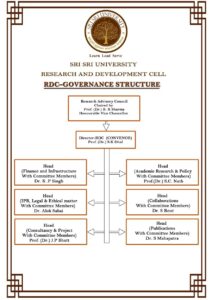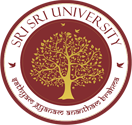Research and Development Cell
Introduction
Research and innovation in SRI SRI UNIVERITY are important aspects to enhance quality research aligned with UGC guidelines. Societal challenges of our country can only be addressed by having a strong and vibrant higher education ecosystem with an emphasis on research, innovation, and technology development. The integration of Research, Innovation and Technology Development is the foundation of Atma-Nirbhar Bharat (Self-reliant India). The establishment of Research and Development Cell (RDC) in SRI SRI UNIVRSITY will enable attainment of targets of Atma-Nirbhar Bharat and is expected to play a pivotal role in catalyzing multidisciplinary/ transdisciplinary and translational research culture mandated in NEP 2020 by University Grant Commission.
Vision
To put in place a robust mechanism for developing and strengthening the researchecosystem within and outside of SRI SRI UNIVESITY, aligned with the provisions of NEP-2020.
Mission
- To create a conducive environment for enhanced research productivity.
- To encourage collaboration across industry, government, community-based organizations, and agencies at the local, national, and international levels.
- To facilitate greater access to research through mobilization of resources and funding.
Objectives
- To create an organizational structure with role-based functions of RDC, formulate Research Policy for the SRI SRI UNIVESITY, identify thrust areas of research, and form related cluster groups/ frontline teams/consortia of researchers.
- To create enabling provisions in Research Policies for recruitment of research personnel, procurement of equipment, and financial management with adequate autonomy to the Principal Investigator(s) and disseminate research outcomes to stakeholders and the public at large.
- To establish a special purpose vehicle to promote researchers and innovators, identify potential collaborators from industry, research organizations, academic institutions & other stakeholders for cooperation and synergistic partnerships.
- To act as a liaison between researchers & relevant research funding agencies, extend guidance in the preparation & submission of project proposals and post-sanctioning of the grants to oversee adherence to timelines.
- To have better coordination among other cells/centers dealing with University-Industry Inter Linkage, Incubation, Innovation and Entrepreneurship Development, and Intellectual Property Rights (IPR).
- To develop an Institutional Research Information System for sharing the status of ongoing/completed research projects/Programmes, expertise & resources, etc., making effective use of Information & Communication Technology (ICT) for preparing the database of in-house experts to provide industrial consultancy and services.
- To engage & utilize the services of superannuated active faculty/scientists in research capacity building of talented young minds and promote mobility of researchers across institutions and R&D Labs.
Functions
The RDC in SRI SRI UNIVERSITY with the mandate for promoting quality research that contributes meaningfully towards the goal of a self-reliant India (“Atma-Nirbhar Bharat”), aligned with the provisions of NEP-2020.
The RDC would help create a research ecosystem for reliable, impactful, and sustained research output. The essential elements of such an ecosystem, viz., generation of knowledge and facilitation of research, innovation and technology development for industrial & societal benefits, are addressed by human resource (researcher & faculty), intellectual capital (knowledge & skills), governance (regulation & policies) and financial resources (funding & grants).
- Governance
- Administration
- Research Ecosystem/Collaboration
- Information Management System
- Human Resources
- Research Promotion & Guidance
- Integrity and Ethics
- Capacity Building
- Research Monitoring
An efficient governance mechanism, which ensures functional autonomy, transparency, accountability, adaptability by strengthening interlinkages to create a conducive research environment.
SRI SRI UNIVERSITY can foster the human elements (faculty, staff, scholars, and students), logistics (land, buildings, and facilities), knowledge resources (research equipment, project utilities, and consumables), fund flow, etc. through a steady, proficient, effective governance (Rules, Norms, and Policies) and financial (Grants and Funds) management. Dedicated leadership and administrative structure for research, led by experienced researchers, are essential for establishing an effective and robust Research Governance in RDC at SRI SRI UNIVERSITY.
The Research Governance will have a Research Advisory Council (RAC) headed by the Vice-Chancellor/Principal or his/her nominee as the apex body of RDC. The Director, nominated by Vice-Chancellor among the distinguished researchers from the university, will head various committees to drive the governance. RDC may form multiple committees to smoothen its functioning with respective committee members nominated by the Director – RDC and approved by RAC. The organisational structure of RDC comprising of various heads for specified functions may be as under:
Established organizational structure (Bodies, Authorities, and Committees) will facilitate the planning, implementation, and monitoring of research activities in SRI SRI UNIVERSITY, formulate rules, regulations, and policy frameworks for the utilization of facilities and resources.
A strategy adopted to integrate multiple functional units can support institutional research under a single-window operational system for effective administration.
The activities of RDC will be mentored and monitored by various heads for devising research models, technology, appraisal, foresight & review functions, mediating sectoral R&D progress, and IPR protection.
RDC should keep close contact with Ministry Innovation Cell to make use of various innovative plans for facilitating the researchers.
A vibrant research ecosystem in SRI SRI UNIVERSITY aims to provide meaningful thrust for sustainable research and innovation and promote collaboration between government, universities, research institutes and industries.
SRI SRI UNIVERSITY need to build a sustainable research ecosystem that leads to consistent quality research outcomes and enhanced productivity.
In order to make RDC functionality viable that are relatively new or not so well established should develop a connection with RDCs of already well-known/established higher educational institutions for their research.
RDC will act as a facilitator for networking and collaborative research with other national and international institutions working in inter-disciplinary, trans-disciplinary, and multidisciplinary research areas. Reformed administrative structure can reach out to key industry players, research organizations, institutions, associations, NGOs, and government bodies to forge strategic partnerships.
RDC need to establish collaborations, teams/consortia, partnerships, and combined ventures for joint research activities through clustering institutions and organizations to facilitate the exchange of students, scholars, and faculty.
There is a need to strengthen resource sharing in content and infrastructure both within the university and among universities, funding agencies, industries, corporates, and the government.
RDC plays a key role in the advancement of research and innovation as two distinct entities through Research Information Management System (RIMS) for the benefit of faculty, students, industry, and other stakeholders.
RDC should put in place a RIMS to collect and manage research-oriented information, databases, publications, research projects, fellowships, collaborations, patents, thrust areas, innovations etc. aligned with the institution’s research policies.
RIMS would also provide a platform for accessing resource-centric information pertaining to human capital (Expertise), physical capital (State- of-Art Research Laboratories and Sophisticated Instrumentation Facility), and knowledge capital (Digital Library &Information, Intellectual Property Facilitation, Quantitative Methods & Data Analysis, Analytical and Consultancy Services).
As per the requirements of various regulatory agencies, researchers can submit, modify, or update their research compliances such as protocol approval, training records, equipment lists, etc. RIMS can provide a centralized and integrated database to manage issues related to and radioactive-safety approval clearances for use and disposal of biological, chemical and radioactive hazardous materials, protective equipment measures, surveillance of staff, appropriate trainings/workshops, etc.
RDC needs to create a blog or portal for Institutional Research Information and Institutional Repository and sign an MoU with UGC- INFLIBNET to access and upload the research information through Shodh Ganga, Shodh Gangotri, Shodh Sindhu, Shodh Shuddhi, and Shodh Chakra.
The Director (RDC), the Conveners and members of various heads (nominated by the Director-RDC from/among the existing faculties with research credentials), and supporting administrative/technical staff would ensure the smooth conduct of the research activities.
Re-employing or designating superannuated faculty/scientists with exceptional research profiles and eminent faculty as Mentors/ Scientists/ Professor Emeritus on a selective basis will help to build a resilient research ecosystem. Distinguished faculties or research scientists grooming young talents can help replenish the void created as a result of superannuated faculty/researchers.
Research promotion activities at the university should be aligned with the mandates of various National Missions, SDGs, Start-up India leading to a Self-Reliant India (Atma-Nirbhar Bharat).
Research Guidance from RDC will aim to encourage faculties to conceive ideas through enhanced industry-academia interactions and prepare research proposals for funding from various agencies. Organizing events like capacity- building programs (Research Methodology and Research Techniques) and specific research theme-based workshops and Research Internships will motivate the end-users (students, scholars, and faculties) to participate actively in the process of ideation and innovative research in emerging areas.
a. Research Thrust and Clustered Areas
Thrust areas for Research should be identified, underpinning the societal needs and the availability of key resources, including in-house human resources, faculty research competencies, and support systems. This would enable the university to consider establishing a Centre of Excellence (CoE) in these identified contemporary areas of research.
Research Clusters and/or Regional Research Consortia prompted/formed by RDC to bring all researchers, faculty, students, scholars, and Post-Doctoral Fellows for joint high-value (interdisciplinary and trans-disciplinary) research projects to avail national and international funding opportunities. Shared infrastructure and expertise will enable cross-fertilization of ideas and mobilization of resources. Further, forming Regional Research Consortia adds a synergistic advantage in finding solutions in inter-disciplinary, trans-disciplinary, and multidisciplinary areas.
CoEs’ can serve as Incubation Centres to transform innovative ideas into processes and products administered and monitored by the proposed RDC. RDC could also provide an avenue for community talent with prior learning/expertise to engage in research and innovation activities.
b. Research Incentives and Recognition
Incentives play a significant role in triggering and catalyzing research interest among scholars and faculties. Incentivizing quality publications and patents by students and faculty will have an enduring positive impact.
Institution of Excellence Awards for accomplishments/achievements in the form of impactful quality research and/ or research-based teaching will further stimulate and invigorate the research and innovation activities of the university.
RDC should also develop a policy focussing on identifying specific intensives for research faculty and develop a unique Research Career ladder for strengthening the mission “Research”.
c. Technology Development and Business Centred Facility
The Technology Development and business-centered facility will be a hub for strategic partnerships/ collaborations, industry-institute interface, sponsored or contract research, new knowledge generation, IPR, and patent services, venture capital, trade/market portfolio, technology transfer, and commercialization of research to facilitate innovation, incubation, entrepreneurship and start-up ventures.
d. Finance
RDC can facilitate resource mobilization and create a Corpus for research and development from government, industry, and other funding agencies and channelize Corporate Social Responsibility (CSR) funds for sustenance and furtherance of research activities. Apart from creating a Corpus fund exclusively for R&D, RDC can explore venture capitalists and angel investors for funding in research and innovation. It needs to liaise with funding agencies, and track funding opportunities from industrial consortia. The university may make provision for research in the annual budget subject to the availability of funds.
The corpus created for research could also support the seed funding for freshly recruited faculty for developing research facilities, publications and patenting.
Regular initiatives by RDC will ensure that researchers understand the importance of integrity and ethics and comply with ethical codes of research and publishing practices at institutional, national, and global levels. A standard plagiarism check should be mandatorily implemented and the requisite software in this regard made accessible to all researchers. In addition, the RDC will sensitize the research community about dubious research and publishing practices and predatory journals.
RDC would play a crucial role in building the capacity of faculty and students to undertake research problems in line with the latest advances in diverse disciplines to push the boundaries of knowledge through publications and contribute to technological developments relevant to societal needs. It would also pave the way for university to attract more research grants under norm-based funding, improve its accreditation ranking and enhance its brand image. Regular events such as refresher courses, workshops, trainings/internships, group discussions and seminars/conferences may be organized for capacity building. RDC would play a pivotal role in creating central R&D facilities with the provisioning of associated training/internship thereon.
The current policy environment in India encourages university to be responsible and accountable for research development and innovation activities through the creation of infrastructure, generation of resources, promotion of business, and facilitation of policy framework to nurture the culture of quality research by adhering to ethical practices. Among the standard functions, the RDC needs to monitor and oversee research progress, coordinate program, manage and facilitate optimizing resources, timely review of research activities for completion of the projects as per schedule.
RDC need to formulate and adhere to specific quality benchmarks for research to meet the global/ international standards. The proposed RDC should conduct a quality review (SWOC Analysis) or internal evaluation of the research papers and suggest Scopus Indexed, Web of Science (WoS), or UGC-CARE recognized journals for appropriate publications.
R & D Cell must ensure that all the Research Labs in the institution fulfill the norms of Good Laboratory Practices (GLP) and Safety (Bio and Chemical) measures, recognized as QIP center and by the National Accreditation Board of Laboratories (NABL).
Proposed Governance Structure of Research and Development Cell
An efficient governance mechanism, which ensures functional autonomy, transparency, accountability, adaptability by strengthening interlinkages to create a conducive research environment
Director (RDC)-Engagement
- The Director (RDC), Nominated by the Vice Chancellor among the existing faculties with research credentials
- He may be assigned to lead the Research Development Cell for a span of three years among the professor having minimum five years’ experience in the university
- As per need and requirement, He may be engaged for maximum four papers per year and relived from other responsibility in his parent department
- He will report to Chairman of Research Advisor council
- A Quaterly summarised report will be prepared and conveyed to the Chainman Research Advisory council with the following information heads (RDC)-Engagement
- The HEADS (RDC), Nominated by the director RDC among the existing faculties with research credentials
- He may be deputed to Research Development Cell for a span of three years among the faculties having some credential
- He may be engaged for maximum six papers in a year (three paper in a semester) and relived from one and half a day from his/her departmental responsibility
- He will report to Director RDC on these days related to his assigned responsibilities
- A quarterly summarised report will be prepared and conveyed to Director RDC with appropriate information
Research Advisory Council
| Sl. No. | Name and Designation | Role of the Advisory Body |
|---|---|---|
| 1. | Prof. (Dr.) B.R. Sharma, Vice Chancellor, Sri Sri University | Chairman |
| 2. | Prof. (Dr.) Sunil Kumar Dhal | Convenor |
| 3. | Prof. (Dr.) Ishwar Basava Reddy, Director, Morarji Desai National Institute of Yoga | Advisor |
| 4. | Prof. (Dr.) Nalini Prabha Tripathy, Director Research and Development IIM, Shilong | Advisor |
| 5. | Prof. (Dr.) Alok Mittal, Professor(HAG)MA-NIT, Bhopal | Advisor |
| 6. | Prof. (Dr.) Bisnu Prasad Das, Ex- Director R & D, F.M. University, Balasore | Convenor |
| 7. | PProf. (Dr.) Sanjeev Sharma, Vice Chancellor, National Institute of Ayurveda (Deemed University) | Advisor |
| 8. | Dr. (Dr.) N. Bhattacharya, Director, C-DAC, Kolkata | Advisor |
| 9. | Dr. (Dr.) Vasanta Parida, CEO, KEA Tech Solution, Cuttack | Advisor |

